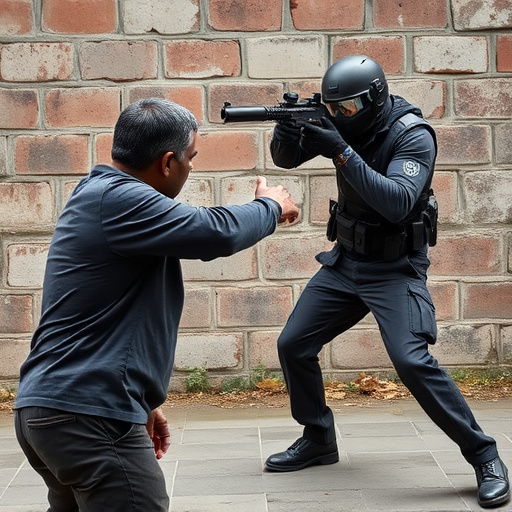Mastering Self-Defense: Your Guide to Stun Gun Training and Certification
Non-lethal weapon training with tools like stun guns offers a safe, effective alternative to convent…….
Non-lethal weapon training with tools like stun guns offers a safe, effective alternative to conventional firearms for self-defense. Choosing the best-rated stun guns involves considering size, voltage, comfort level, and local regulations. Training through accredited programs ensures proficiency in device operation, legal understanding, and safe deployment strategies. Responsible ownership includes knowledge of local laws, proper storage, regular testing, and attending certified training sessions to maximize effectiveness as a last resort.
“Uncover the power of non-lethal weapon training and certification, a vital step towards empowering yourself with effective self-defense tools. In today’s world, understanding how to utilize stun guns can provide peace of mind and enhanced safety.
This comprehensive guide explores the benefits of non-lethal force, guiding you through the process of choosing the best-rated stun guns suitable for your needs. From certification preparation to legal insights and safety practices, it equips you with the knowledge to make informed decisions regarding self-defense.”
- Understanding Non-Lethal Weapon Training and Its Benefits
- Choosing the Right Stun Gun for Your Needs
- The Certification Process: What to Expect and Prepare For
- Legal Considerations and Safety Tips for Stun Gun Owners
Understanding Non-Lethal Weapon Training and Its Benefits

Non-lethal weapon training, focusing on tools like stun guns, offers a vital alternative to conventional firearms for self-defence. These devices are designed to incapacitate an aggressor temporarily, giving individuals the chance to escape dangerous situations safely. Training in their use is crucial, ensuring users understand how to deploy them effectively and responsibly while mitigating risks.
The benefits of such training extend beyond personal safety. It promotes a culture of proactive self-defence, empowering folks with knowledge that can deter potential threats. Moreover, it allows individuals to choose the best-rated stun guns for self-defense, leveraging technology to protect themselves without resorting to lethal force unless absolutely necessary. This approach reflects a modern, informed perspective on safety and security.
Choosing the Right Stun Gun for Your Needs

When it comes to selecting a stun gun, choosing the right one depends on your specific needs and preferences for self-defense. The best-rated stun guns for self-defense offer a range of features, power levels, and sizes to suit different scenarios and users. For instance, if you prioritize portability and discreetness, smaller, compact stun guns with low voltage settings might be ideal. These devices are easy to carry and can be easily concealed in pockets or purses.
On the other hand, larger stun guns with higher voltage output are more suitable for those seeking maximum impact. These powerful tools are designed to incapacitate an assailant quickly and effectively, making them popular choices for individuals who want a more robust self-defense option. Consider your comfort level, intended usage, and local regulations when selecting the best stun gun that meets your personal requirements for self-protection.
The Certification Process: What to Expect and Prepare For

The certification process for non-lethal weapon training, such as stun gun use for self-defense, involves several steps designed to ensure safety and proficiency. Expect a series of theoretical and practical assessments that will test your understanding of the device’s operation, its legal implications, and effective deployment strategies. Begin by researching and choosing an accredited training program or instructor; look for those offering the best-rated stun guns for self-defense as part of their curriculum.
Prepare for your certification by familiarizing yourself with the specific rules and regulations regarding stun gun ownership and use in your jurisdiction. This includes understanding safe handling practices, potential side effects, and legal restrictions. During training, you’ll learn how to operate a stun gun correctly, including maintenance, charging, and aiming techniques. Practice these skills under professional supervision until you feel confident enough to deploy the device safely and effectively in self-defense scenarios.
Legal Considerations and Safety Tips for Stun Gun Owners

When owning a stun gun, understanding legal considerations and safety tips is paramount. Each jurisdiction has its own regulations regarding the possession and use of stun guns, so it’s crucial to research and comply with local laws. Check if your state or region falls under the federal government’s list of prohibited areas for stun gun ownership. Owning a best-rated stun gun for self-defense should never lead you to disregard safety protocols. Always treat your stun gun as if it is loaded, and keep it stored safely when not in use. Familiarize yourself with its operation and maintain proper handling techniques to ensure the device functions correctly during an emergency.
Safety tips extend beyond legal boundaries. Stun guns emit a powerful electric current that can cause temporary incapacitation, but they are not foolproof against determined attackers. They should be used as a last resort when facing imminent danger. Regularly test your stun gun and check its battery life to ensure it’s always ready when you need it. Additionally, consider attending certified training sessions for non-lethal weapon use to learn effective self-defense strategies that complement your stun gun ownership.
Non-lethal weapon training certification equips individuals with valuable skills for personal safety, enabling them to make informed choices among best-rated stun guns for self-defense. By understanding the benefits, selecting the right device, and adhering to legal guidelines and safety practices, you can confidently navigate self-defense options. This comprehensive guide ensures you’re prepared, armed—metaphorically speaking—with knowledge, and ready to take control of your well-being.


